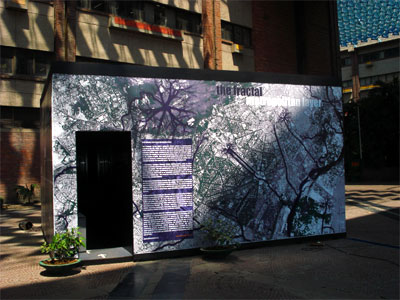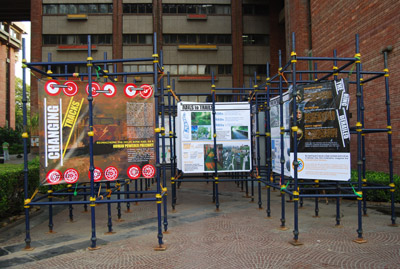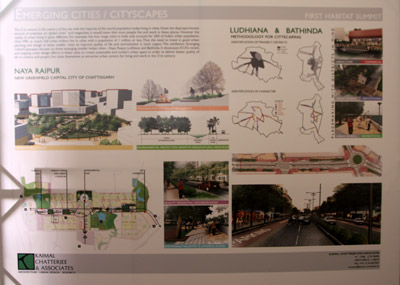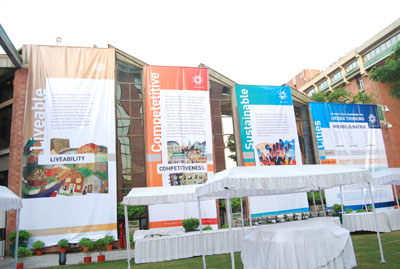|
Titled “Possibilities”, the Urban Expo component of the
Habitat Summit is public-facing and will feature accessible
displays and installations that project the possibilities
our cities have for radical improvement through innovative
thinking and via the deployment of “organic interventions”.
The Expo will feature the work of leading architects and
urban thinkers engaged with building sustainable built
environments.
Top
DELHI NULLAHS: THE FRACTAL METROPOLITAN LAYER
www.delhinullahs.org
|
'The
fractal metropolitan layer' is an endeavor in progress by
Morphogenesis, that aims to reveal the hidden opportunity
that lies within our organically evolved cities by
establishing a green and sustainable network as an
alternative source of engagement with the city for the
common man. The initiative aims to reclaim the derelict, the
forgotten, the recyclable, and the toxic by involving all
stakeholders, thereby collapsing the boundaries of decades
of non-systemic thinking which have generated unsustainable
urban growth. The contiguous, sewage-laden nullahs,
the greens, the alleyways and the river are viewed as the
arteries of a city that can be linked to create an
environmental network which integrates livability issues of
air, water, sewerage, heritage and walkability. These
ecological potentials and vestigial organs of planning can
be modulated, transformed, and spatial strategies devised to
optimize the ecological, social, cultural, and economic
dynamic that can be created through them.
|
|

The Morphogenesis Delhi Nullahs installation live
at the India Habitat Centre
|
The installation aims to create awareness by engaging
people, to speculate on what is and what can be, by bridging
the gap between the reality of our cities as perceived from
the outside, and the virtual image of what Delhi potentially
is. The tree has been used as a metaphor and a fractal
insert into the fabric of the city; representative of our
symbiotic relationship with Nature, and its omnipresence in
Delhi.
Top
CHANGING
TRACKS
 In
the mid seventies, work began on laying a railway line that
would circumscribe the extents of New Delhi at that time.
Originally called the “Delhi Avoiding Line”, it was
meant to decongest the existing interstate lines between
Hazrat Nizamuddin Station (HZN) and Sarai Rohilla Station
(DEE) so that this zone could more effectively serve
passenger trains by using this line to shunt goods traffic.
The idea was to connect HZN and DEE stations with the newly
settled residential colonies of West Delhi and the vast
central government housing areas of South Delhi. The
Northern Railways then introduced the Ring Rail Sewa as an
augmentation of the existing public transport network of DTC
buses in time for the 1982 Asiad Games. The manner in which
the city has grown subsequently, the development of other
transport networks and numerous systemic issues have left
this urban transport system grossly underutilised. In
fact,the city has slowly turned its back on the Ring Rail
and it has become a forgotten asset that is hidden from view
except for an occasional glimpse from an overpass. In
the mid seventies, work began on laying a railway line that
would circumscribe the extents of New Delhi at that time.
Originally called the “Delhi Avoiding Line”, it was
meant to decongest the existing interstate lines between
Hazrat Nizamuddin Station (HZN) and Sarai Rohilla Station
(DEE) so that this zone could more effectively serve
passenger trains by using this line to shunt goods traffic.
The idea was to connect HZN and DEE stations with the newly
settled residential colonies of West Delhi and the vast
central government housing areas of South Delhi. The
Northern Railways then introduced the Ring Rail Sewa as an
augmentation of the existing public transport network of DTC
buses in time for the 1982 Asiad Games. The manner in which
the city has grown subsequently, the development of other
transport networks and numerous systemic issues have left
this urban transport system grossly underutilised. In
fact,the city has slowly turned its back on the Ring Rail
and it has become a forgotten asset that is hidden from view
except for an occasional glimpse from an overpass.
A quarter century later, as Delhi prepares to host its
next international sports mega-event, this installation
revisits the Ring Rail to investigate its value as an urban
space for Delhi and its potential to make Delhi more
inclusive.
Top
EMERGING
CITIES/CITYSCAPES
 The 21st century is the century of the city with the
majority of the world population today living in cities.
Given the disproportionate amount of emphasis on “global
cities” or megacities, it would seem that most people live
and work in these places. However the reality of urban
living is quite different. In India, for example, the four
mega cities only account for 26% of India’s urban
population. Over 49% or nearly half urban Indians live in
cities with a population of 1 million or less. Thus the need
to invest in good urban planning and design in these smaller
cities to improve quality of life and environment is most
urgent. This exhibition, Emerging Cities/Cityscapes, focuses
on three emerging smaller Indian cities—Naya Raipur,
Ludhiana and Bathinda. It showcases KCA’s recent and
ongoing urban design efforts in these cities to create
sustainable and modern urban space in order to deliver
better quality of life to citizens and project the cities
themselves as attractive urban centers for living and work
in the 21st century. The 21st century is the century of the city with the
majority of the world population today living in cities.
Given the disproportionate amount of emphasis on “global
cities” or megacities, it would seem that most people live
and work in these places. However the reality of urban
living is quite different. In India, for example, the four
mega cities only account for 26% of India’s urban
population. Over 49% or nearly half urban Indians live in
cities with a population of 1 million or less. Thus the need
to invest in good urban planning and design in these smaller
cities to improve quality of life and environment is most
urgent. This exhibition, Emerging Cities/Cityscapes, focuses
on three emerging smaller Indian cities—Naya Raipur,
Ludhiana and Bathinda. It showcases KCA’s recent and
ongoing urban design efforts in these cities to create
sustainable and modern urban space in order to deliver
better quality of life to citizens and project the cities
themselves as attractive urban centers for living and work
in the 21st century.
Top
MIRABILIS MATRIX
The Mirabilis Matrix: An Analytical Framework for Urban
Thinking
| |
Hardware |
Software |
Governance |
| Liveability |
Good quality housing and amenities
like parks, hospitals, clubs and schools |
Social networks & interaction.
Clustering of amenities to create "urban
buzz", a sense of place and history. |
Safety and enforcement of Law.
Simple and well enforced system of municipal regulation. |
| Competitiveness |
Transport & Communications
links. Quality of office/ commercial space. |
Clustering of human capital and
ability to attract talent, socio-cultural openness. |
Reasonable tax rates. Efficient governance
structures. |
| Environmental
Footprint |
Public transport, density, green
spaces, waste management, etc. |
Environmental consciousness, low
impact lifestyles. |
Air and water quality. Sustainable
practices with regard to water supply & usage, etc. |
The Mirabilis Matrix is an analytical framework for urban
thinking. It encompasses three verticals: Hardware, Software
and Governance. The horizontals are: Liveability,
Competitiveness and Environmental Footprint. It
provides a way to think about how different elements come
together to form a successful city.
This is not a priority list but a way to think about how
a successful city comes together by combining different
ingredients. Successful urban planning is about organically
combining these facets. This is not a “mechanical”
approach but one that explicitly thinks of the city as an
evolving eco-system.
 Definitions: Definitions:
The Horizontals
Liveability: At the most fundamental level, cities
are to be lived in. To succeed, they must be pleasant places
to live, work and play for a large cross-section of the
society. Hardware, software and governance are all important
factors that define liveability. There is no set formula for
how these ingredients combine to make a city liveable.
Different cities have evolved different recipes that fit the
particular needs of particular societies.
Economic Competitiveness: For time immemorial,
cities have competed for influence, power and commerce. In
the nineteenth and twentieth centuries, this often meant
growing and harnessing their industrial prowess. In the
twenty-first century, however, cities will compete in terms
of their ability to bring in human capital. Rather than lead
to the dispersion of economic activity, the
telecommunication revolution appears to have increased the
value of clusters of human capital. Thus, London and New
York have emerged as global cities while university towns
like Boston, San Francisco-Bay Area, Oxford and Cambridge
(UK) have witnessed extraordinary revival.
Environmental Footprint: More than half of the
world’s population now lives in urban areas. India too is
likely to be urbanised very quickly over the next few
decades. There is a need to consider the environmental costs
and benefits of this shift. A conscious effort will be
required to design dense cities with public transport
systems and sustainable energy, air and water practices.
The Verticals
Hardware: This includes all the
residential/commercial buildings, roads, theatres, museums,
stadiums, airports and so on that constitutes the physical
form of a city - the material manifestation of the city.
Clearly these are very important but, in India, all urban
thinking and planning seems sometimes to be limited only to
this aspect.
Software: This relates to all the activities that
people conduct in the urban space. This includes economic
activities as well as socio-cultural interactions that give
a city its life. To provide an analogy, as a computer’s
hardware must allow the software to function correctly, a
city must provide adequate physical infrastructure to enable
its citizens to perform well. Grand and expensive projects
do not always create great cities if they do not actively
engage with the lives of the citizens.
Governance: Cities are complex systems and they
require constant regulation/management in order to function
efficiently. Rules must be rational and their enforcement
must be visible and even-handed. Very little thought is
given to this aspect in India even in its major cities.
Gurgaon, for instance, is still run as if it was a small “moufassil”
town, even as different promoters create a random mix of
management systems for their individual developments. There
is no consistent set of municipal rules or a transparent
system for enforcement.
Top
URBAN INDIA THROUGH
THE LENS
 India
is home to some of the oldest cities in the world and to
some of newest. Three photographers explore how this journey
has impacted urbanity in contemporary India. The collection “Urban
India Through The Lens” by Mala Mukerjee , Chandan
Dubey and Smita Barooah Sanyal will be showcased from 10
Sept to 30 Sep 2009 at Galleries 4A and 5A, India Habitat
Centre, Lodhi Road, New Delhi. India
is home to some of the oldest cities in the world and to
some of newest. Three photographers explore how this journey
has impacted urbanity in contemporary India. The collection “Urban
India Through The Lens” by Mala Mukerjee , Chandan
Dubey and Smita Barooah Sanyal will be showcased from 10
Sept to 30 Sep 2009 at Galleries 4A and 5A, India Habitat
Centre, Lodhi Road, New Delhi.
Top
PAN INDIA, a shared
habitat
An exhibition of photographs by Prashant Panjiar
'Pan India, a shared habitat' is a personal photographic
project, begun in the new millennium, that seeks to observe
the visual landscape of India at the cusp of change and to
reflect upon the ways we live.
The exhibition can be viewed at the Visual Arts Gallery,
India Habitat Centre from 25 September to 5 October 2009,
daily 11 am to 7 pm.
The exhibition also travels to Bangalore (20 to 30
October 2009), Kolkatta (19 to 29 December 2009)
and Mumbai (26 January to 3 February 2010).

|